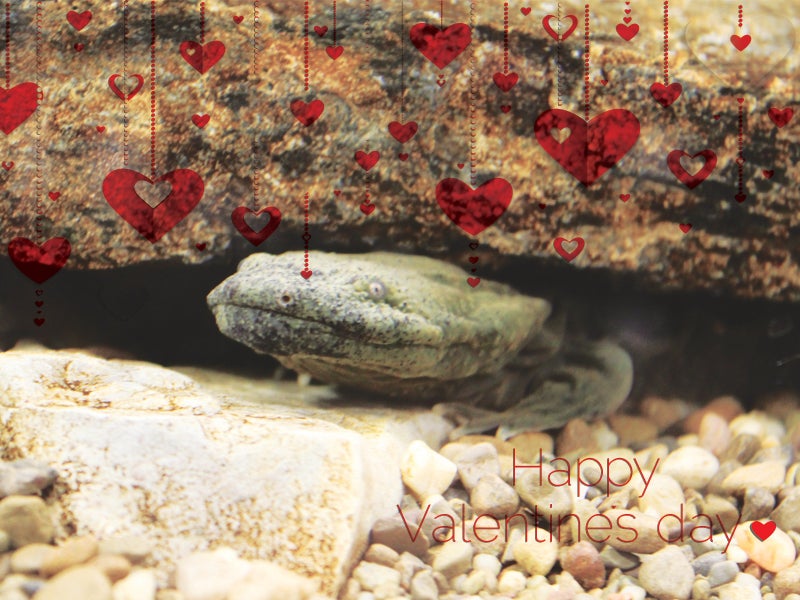We Can’t All Be Eagles, But We All Need Love
This Valentine’s Day, Earthjustice gives a shout-out to the not-so-cuddly creatures we’re working to protect, from snot otters to cave dwellers and everything in between.

This page was published 9 years ago. Find the latest on Earthjustice’s work.
Earthjustice protects many animals that are under threat, and some of them are, shall we say, less visually appealing than others. This Valentine’s Day, we’re giving the spotlight to these often-overlooked creatures. From cat-sized salamanders to tiny fish, each one of these featured creatures plays a critical role in the larger ecosystem and deserves a spotlight. After all, we can’t all be eagles, but we all need love.
Hellbender Salamander
North America’s largest salamander, hellbenders are known by many colorful names, including “big water lizard,” “devil dog” and “snot otter”—the latter because of their tendency to secrete mucus-like goo when threatened. These fully aquatic salamanders live in fast-flowing rivers and streams, where they prefer to lurk under heavy rocks and wait for passing prey. Hellbenders can live well into their 50s and are especially loyal to their territory, often found under the exact same rock year after year.
The hellbender’s habitat is under assault from pollution and development and the species is listed as endangered in Maryland, Ohio, Illinois and Indiana. However, the salamander doesn’t currently have this protection in New York state, where two river habitats crucial to its survival are under threat. In 2014, Earthjustice petitioned the New York State Department of Environmental Conservation (DEC) to list the hellbender salamander as endangered. Despite substantial scientific research documenting the hellbender’s decline, the DEC denied the petition but committed to reviewing the hellbender’s status as part of its ongoing revision to the state’s list of Species of Greatest Conservation Need.
Northern Long-Eared Bat
This bat has some surprisingly large ears compared to other bats in its genus, Myotis, which literally means “mouse-eared.” Found across North America, the northern long-eared bat likes its alone time and prefers to find shelter in small crevices and holes rather than in the open areas of caves like other bat species. When on the look-out for a northern long-eared bat, it’s likely that only its big ears will give away its hiding place.
Unfortunately, the northern long-eared bat is the bat species most devastated by white-nose syndrome, a fungal growth that has killed millions of bats across North America in the last decade. The northern long-eared bat has declined by a staggering 99 percent in the Northeast since 2006. Recently the Fish and Wildlife Service came out with a rule that classified the species as “threatened.” Groups like Earthjustice are busy reviewing the new rule to determine whether it adequately protects the bat.
Lesser Prairie Chicken
Lesser prairie chickens are actually pretty cute and fascinating creatures, but you would never guess it by their name.
Across the southern Great Plains, the male lesser prairie chickens put on an elaborate show to impress the females, flaunting the red air sacs on their necks and making bubbling, popping sounds called “booming.” The mating ritual, commonly known as lekking, incites fervid competition among the males and ultimately rewards those with the most passionate displays. Oklahoma even has a lesser prairie chicken festival in April that advertises an amazing prairie experience.
Back in the days when an estimated one million prairie chickens inhabited the plains, the sounds of this courtship perhaps did indeed “boom.” But over the years, though, populations of lesser prairie chickens have suffered a “rapid and severe decline,” due primarily to habitat fragmentation. The bird currently lives on only 16 percent of its historic five state range—Texas, Oklahoma, Kansas, Colorado and New Mexico— and has been forced off much of its land due to oil and gas production and development of wind farms, roads and transmission lines. In 2014, the U.S. Fish and Wildlife Service listed the lesser prairie chickens as “threatened” under the Endangered Species Act. Federal protections for the lesser prairie chicken have been politically controversial due to claims that these protections could affect oil and gas development. Earthjustice has been steadfast in beating back all congressional efforts to remove or undermine the bird’s protections.
The Delta Smelt
The delta smelt could literally be a fish out of water if Big Ag interests in California have their way. The fish species—no more than three inches in length—can only be found in the Sacramento-San Joaquin Delta, which is the central battleground over Calfornia’s water supply. The freshwater flows through the Delta have historically supported valuable commercial and sport fisheries and provided irrigation water for Delta farmers and drinking water for millions of California. The delta smelt, protected under the Endangered Species Act since 1993 and an indicator species of the overall health of the Delta ecosystem, is at the helm of the controversy over water rights in drought-ridden California.
The controversy has been heated. One congressional representative, Rep. Devin Nunes (R-CA), is even on record as calling the smelt a “stupid little fish” that doesn’t deserve water. Agricultural interests and their friends in Congress often attribute the lack of irrigation water to these water restrictions to protect the smelt, but nothing could be further from the truth. Since the early ‘90s, Earthjustice has fought continual attacks against the smelt to aid not only this fish, but the entire Delta ecosystem and the myriad species it supports.
Add your voice to the chorus of those who want to uphold the Endangered Species Act—our best defense in saving all creatures—no matter what they look like!